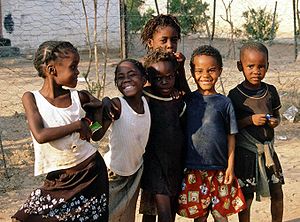 Image via Wikipedia
Image via WikipediaIt is a warm Sunday afternoon for this time of year. The sun has been shining all day and the wind has been progressively abating. Children can be heard playing in a back yard nearby, and the birds are preparing for the onset of evening. I sit at the computer which hums gently as I type. This scene is composed of spatial elements and social conventions much more than it is by my psychology apart from a desire to understand and communicate this understanding.
There is a world of relationships that exist beyond my body. It enters my body only as an after-image of that reality and in the form of language patterns given to me by others. It is true that as a poet I have invented the odd word and often in syncronicity shared that with others who too have invented the same or similar words and phrases in isolation. but this is, and always will remain, the exception rather than the rule. We are born into a world of concepts and relationships and are introduced to these through language and social conventions.
Sunday is not just any day. I live in a society predominately descended from the Western Judeao-christian tradition. As such, Sunday is the first day of the week through convention and traditionally a day of peace. I like this idea and so try to project that onto my world and read it in a way in accordance with the concept that I have inherited along with others. It is quieter because the week ended yesterday and the children can play and the adults relax in preparation of another week of work and learning.
The spatial relationship is also important. While the computer sits foregrounded as I seek to write another blog prompted by a Facebook friend, the children are some distance off and perceptible only through earshot. If they happened to be in my tiny flat it would not be as serene and peaceful. Indeed, if they were playing at the same distance but in the middle of a busy intersection during tomorrow morning's peak hour, I would probably be quite distressed with a feeling of responsibility for their combined safety.
The birds, too, would be problematic if they were in the room with me. Full of fear and anxiety as they tried vainly to escape the confines of my bungalow, they would know doubt fly into walls, me and my computer, making it almost impossible for me to write anything.
I can imagine all this only through prior experience, either personal or conveyed to me in linguistic blocks and phrases, which describe certain behaviours and preclude others. These social relationships that are present in language are appear always already there, to have an a priori existence and come to me in the forms of bodily feelings and postures.
At the moment I am relaxed and peaceful because of what I have described above as the scenario that exists in my immediate surroundings. If it were as I have imaginatively described my body would start to feel anxious and affect the very words and behaviours that are necessary to communicate with others.
This is not trivial. Objects in our perceptual field exist in relation to me and to each other. That relationship is inseparable except in text books that seek to isolate and focus on one object to the exclusion of others momentarily so as to seek an understanding of that object's essential characteristics. In reality, however, an object can never be fully understood in such isolation in its complexity.
Concepts and ideas, like objects, are also in such a relationship with each and the particular social milieu that they inhabit, that is, they exist defined by space and time and as such are essentially historical in nature. A table is built from already existing materials according to the fashions of the time. At times fashion itself is backward looking and so it may be a reproduction design from an earlier era. At others its design will be inspired by an imaginary future.
In either case, what is being built is a functional contemporary object whether its creators see it this way or not. As well as this, the table is built from pre-existing materials and transformed into an object which its makers recognise as an object with the functional attributes of a table. Furthermore, at some future time it will cease being a table and the materials consumed in its transformation will either be utilised for some other human purpose or return again to a static state able to be re-transformed into some other object of utility either by human, animal or some other naturally occurring force.
Ideas, concepts and memories, that is, those human constructions that exist on the Invisible rather than Visible plane, are no different. Sure, they can be externalised in the form of the written word and transmitted via books, texts or indeed performances, yet they are still constructed in much the same way from the linguistic fragments of 'natural world' and given life through the spoken or written word, music and paintings, mathematical concepts and the body of knowledge described, recorded and experimented with in some sort of 'scientific' endeavour.
The Invisible realm is just as real as that which we can directly perceive. Indeed, as I began, this realm always seems to be already present before we even try to speak, just sitting around encapsulating the solidity of the reality we move amidst.
'It is Sunday' seems like such a simple statement, yet is pregnant with social and historical connotations, in constant flux as an object precisely because it exists amidst the flux of ideas that we as humans continually project and receive through our various perceptual apparati. It is our failing as Image by JanetandPhil via Flickranimals that we need to isolate to understand, and so to come to a richer understanding we need to constantly remember this limitation of the way we are in the world.


No comments:
Post a Comment